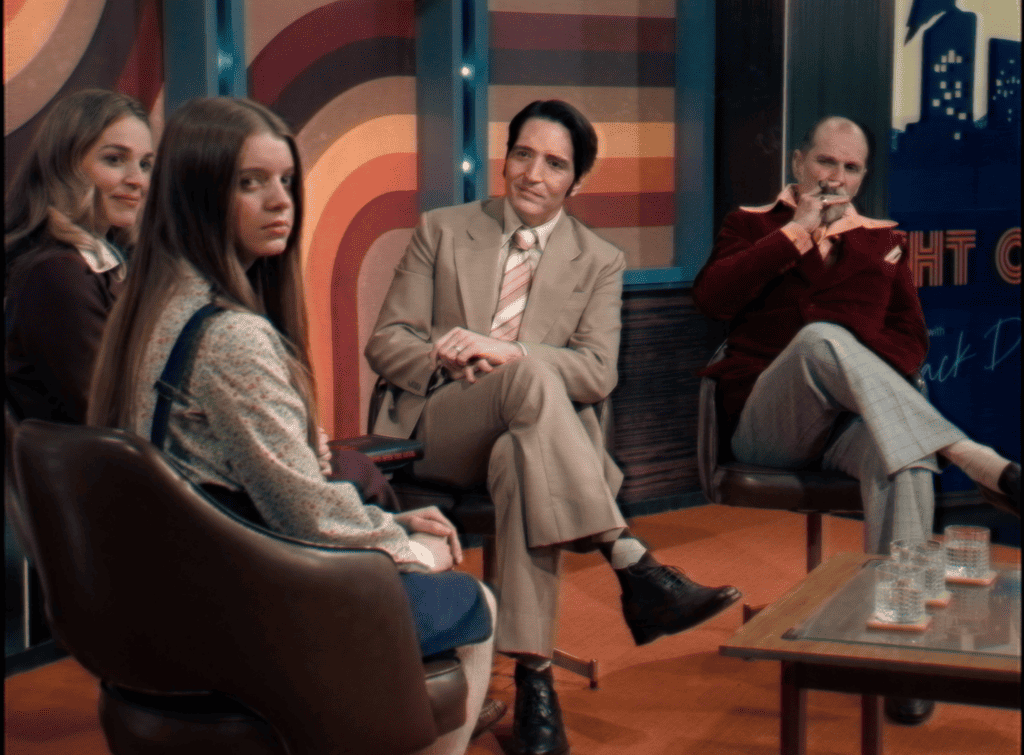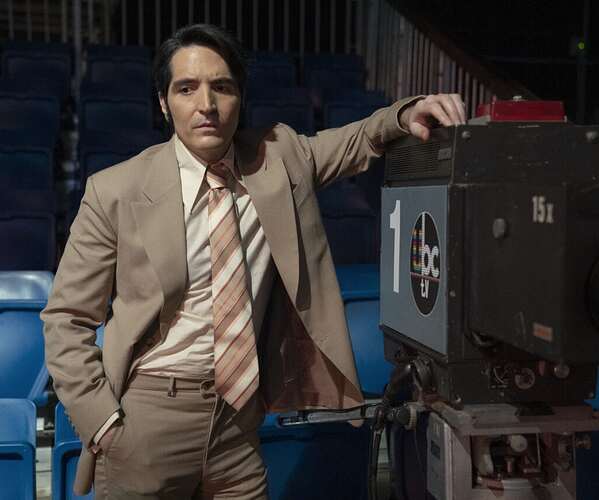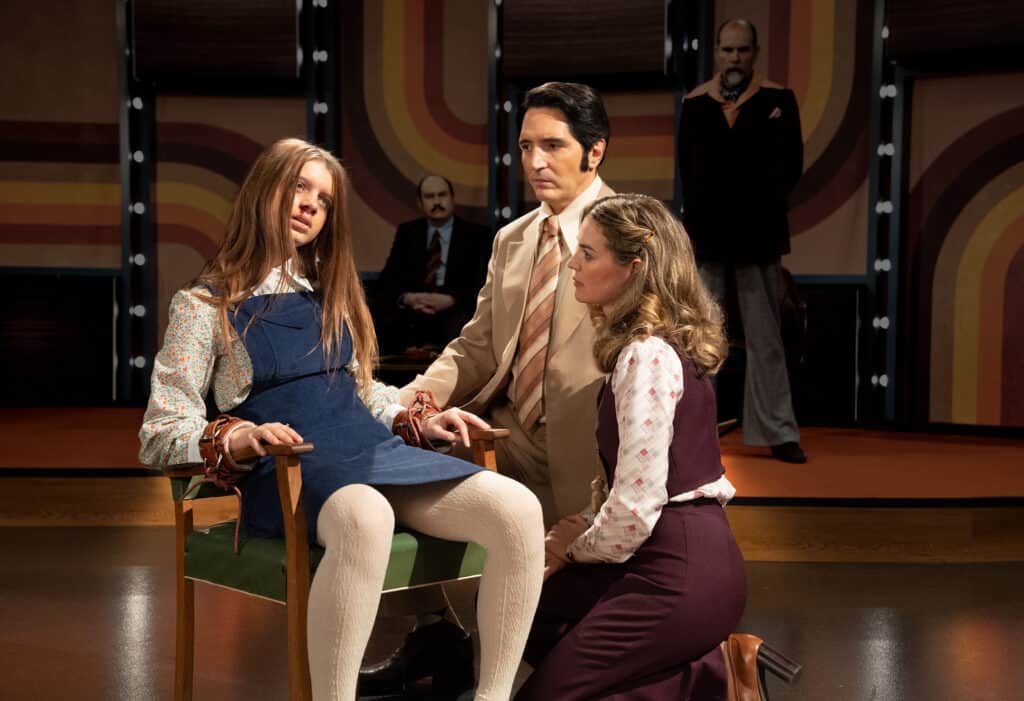Originally published at: A Late-Night Séance (Or Livestream) with "Late Night with The Devil" at The Alamo Drafthouse -
Author: Tania Escobar
As the witching hour approaches and shadows dance along the walls, an eerie silence falls over the crowd at The Alamo Drafthouse. The stage is set for a night that will be etched in the annals of horror history. In a special screening followed by a live stream Q&A at The Alamo Drafthouse, audiences were treated to a unique cinematic experience: Late Night with The Devil. Starring Dave Dastmalchian in a role that carves a new notch in the bedpost of horror, this film takes us back to a 1970s late-night talk show. But as the camera rolls, a sinister narrative unfolds in front of the lens and behind the scenes.
Dave Dastmalchian, known for his versatile roles, embraces the character of Jack Delroy, the “aw shucks mid-western” host of “Night Owls.” Dastmalchian felt immersed and almost a little scared stepping onto a well-designed set made for a late-night talk show with a live band and live studio audience having to deliver the opening monologue for “Night Owls”; it took him back to his first movie role on the set of The Dark Knight. Dastmalchian’s usual roles in films are supporting characters or relatively short scenes to make an appearance for a funny bit, but the pressure was on to put on the talk show host’s charm. His confidence in his writers, who knew the genre very well and shared a mutual love for the genre, had him trust the process in his talk show host role. Discussing his role, Dastmalchian shared, “Being on that set, 90% of your work is essentially on a talk show set. Your set, studio audience, band, that’s an interesting atmosphere.” This environment brought an authentic feel to the film, reminiscent of Dastmalchian’s theater background and his early roles in cinema, adding a layer of immersion that few films can claim.
The Devil’s in the Details
With a shoestring budget, Late Night with The Devil relied heavily on practical effects, or as Dastmalchian put it, “ancient” effects. “There’s a tension… there’s this ratcheted stake in the day when there’s all these artist pumping the blood pumps and they’re getting ready, and the latex is perfectly at the right spot… there’s this palpable kinetic energy.”
Dastmalchian’s favorite scenes that added on to his performances were the special effects horror scenes that gave him and the rest of the crew real time reactions to these effects that gave the scene some authenticity. This approach not only added a tangible tension on set but also demanded excellence and creativity from the cast and crew. The result? A film that feels as real to the audience as it did to those making it. Dastmalchian noted the palpable kinetic energy during the special effects scenes, bringing an authenticity that can’t be replicated with CGI.
One Take Wonder
In the heart of Late Night with The Devil lies a filmmaking approach that challenges conventional norms and enhances the film’s storytelling fabric—its commitment to long takes. This method isn’t just a stylistic choice; it’s a conduit through which the tension, realism, and live energy of the 1970s late-night talk show setting are palpably conveyed to the audience. Dastmalchian navigated these extended sequences with exhilaration and trepidation. “So as often we were shooting long takes to capture the energy and the essence that you would feel when watching the live broadcast of a late-night talk show,” Dastmalchian shared, revealing the intricate dance of actors and cameras choreographed to maintain the illusion of real-time broadcasting.
The commitment to authenticity extended beyond the performance to the very fabric of the film set. Clad in period-appropriate costumes, camera operators became potential participants in the scene, blurring the lines between the observed and the observers. This ingenious solution to potential continuity errors not only preserved the film’s immersive experience but also highlighted the creative team’s dedication to detail. “They even had some of our camera team dressed in period costumes so if they got caught on camera, it would be okay, we could still use it in the footage,” Dastmalchian explained. This level of meticulous planning and execution exemplifies the film’s innovative spirit and dedication to crafting a unique cinematic experience that engages viewers not just visually but emotionally, transporting them to a time when late-night television was a groundbreaking frontier in entertainment.
Final Words
During the revealing Q&A with Dastmalchian, the conversation turned towards the inspirations behind Late Night with The Devil. Dastmalchian confirmed the film’s spiritual homage to Ghost Watch. For those unfamiliar, Ghost Watch was a groundbreaking British television film aired in 1992, masquerading as a live broadcast investigating paranormal activities in a London home. Its blending of reality and fiction terrified viewers and left a lasting impact on how horror could be presented in a seemingly live format. Dastmalchian expressed his admiration, “That is a classic, it’s something, the first time you saw it… We talked about it immediately because that was something I brought up, I was like this carries that spirit of that and the Cairnes Brothers were like yes that’s what we want.”
But perhaps the most haunting takeaway from the interview was Dastmalchian’s reflection on the film’s haunting final line: “Dreamer, here, awake.” This line, repeated with a chilling cadence, transcends the boundaries of the screen, reaching into the audience’s psyche. Dastmalchian shared a deeply personal connection to this line, touching on moments of despair, trauma, and the blur between reality and the supernatural. “I’ve certainly had a few of those and I have definitely stood there thinking, ‘I need to wake up from this’ and didn’t,” he confided. This acknowledgment of human vulnerability and resilience resonates deeply, suggesting a blend of metaphysical and scientific exploration through the protagonist’s journey.
“Dreamer, here, awake,” thus serves as a mantra, a plea, and perhaps a glimmer of hope amidst the darkness. It’s a line that invites interpretation, encouraging the audience to find their own meaning in the labyrinth of their personal experiences with fear, loss, and the desire for awakening.
As Late Night with The Devil invites us to ponder the mysteries that lurk within the dark. This masterpiece, brimming with devilish charm, entertains and resonates with the soul, standing out as a rare gem in the realm of horror.
So, dear readers, as you sit on the edge of your seats, remember: the next time the world around you seems to crumble, maybe, just maybe, a whisper of “Dreamer, here, awake” will be your salvation.
Catch this chilling spectacle in theaters on March 22nd and streaming on Shudder on April 19th—if you dare.


